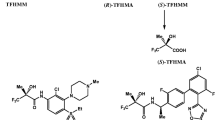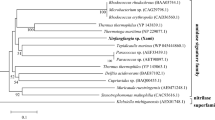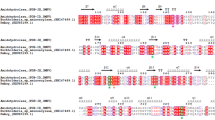Abstract
A novel amidase gene (bami) was cloned from Brevibacterium epidermidis ZJB-07021 by combination of degenerate PCR and high-efficiency thermal asymmetric interlaced PCR (hiTAIL-PCR). The deduced amino acid sequence showed low identity (≤55 %) with other reported amidases. The bami gene was overexpressed in Escherichia coli, and the resultant inclusion bodies were refolded and purified to homogeneity with a recovery of 22.6 %. Bami exhibited a broad substrate spectrum towards aliphatic, aromatic and heterocyclic amides, and showed the highest acyl transfer activity towards butyramide with specific activity of 1331.0 ± 24.0 U mg−1. Kinetic analysis demonstrated that purified Bami exhibited high catalytic efficiency (414.9 mM−1 s−1) for acyl transfer of butyramide, with turnover number (K cat) of 3569.0 s−1. Key parameters including pH, substrate/co-substrate concentration, reaction temperature and catalyst loading were investigated and the Bami showed maximum acyl transfer activity at 50 °C, pH 7.5. Enzymatic catalysis of 200 mM butyramide with 15 μg mL−1 purified Bami was completed in 15 min with a BHA yield of 88.1 % under optimized conditions. The results demonstrated the great potential of Bami for the production of a variety of hydroxamic acids.








Similar content being viewed by others
References
Agarwal S, Choudhury B (2014) Presence of multiple acyltransferases with diverse substrate specificity in Bacillus smithii strain IITR6b2 and characterization of unique acyltransferase with nicotinamide. J Mol Catal B Enzym 107:64–72. doi:10.1016/j.molcatb.2014.05.017
Agarwal S, Gupta M, Choudhury B (2013) Bioprocess development for nicotinic acid hydroxamate synthesis by acyltransferase activity of Bacillus smithii strain IITR6b2. J Ind Microbiol Biotechnol 40:937–946. doi:10.1007/s10295-013-1299-x
Ando W, Tsumaki H (1983) A facile preparation of aliphatic hydroxamic acid from N,N,O-tris (trimethylsilyl) hydroxylamine and acid chloride. Synthetic Commun 13:1053–1056. doi:10.1080/00397918308082726
Bhatia RK, Bhatia SK, Kumar V, Bhalla TC (2015) Bi-substrate kinetic analysis of acyl transfer activity of purified amidase from Pseudomonas putida BR-1. Catal Lett 145:1033–1040. doi:10.1007/s10562-014-1467-2
Bhatia RK, Bhatia SK, Mehta PK, Bhalla TC (2013) Bench scale production of benzohydroxamic acid using acyl transfer activity of amidase from Alcaligenes sp. MTCC 10674. J Ind Microbiol Biotechnol 40:21–27. doi:10.1007/s10295-012-1206-x
Bhatia RK, Bhatia SK, Mehta PK, Bhalla TC (2014) Biotransformation of nicotinamide to nicotinyl hydroxamic acid at bench scale by amidase acyl transfer activity of Pseudomonas putida BR-1. J Mol Catal B Enzym 108:89–95. doi:10.1016/j.molcatb.2014.07.001
Bradford MM (1976) A rapid and sensitive method for the quantitation of microgram quantities of protein utilizing the principle of protein-dye binding. Anal Biochem 72:248–254. doi:10.1016/0003-2697(76)90527-3
Brammar WJ, Clarke PH (1964) Induction and repression of Pseudomonas aeruginosa amidase. J Gen Microbiol 37:307–319. doi:10.1099/00221287-37-3-307
Cao H, Jung M, Stamatoyannopoulos G (2005) Hydroxamide derivatives of short-chain fatty acid have erythropoietic activity and induce γ gene expression in vivo. Exp Hematol 33:1443–1449. doi:10.1016/j.exphem.2005.08.007
Chebrou H, Bigey F, Arnaud A, Galzy P (1996) Study of the amidase signature group. BBA-Protein Struct Mol Enzymol 1298:285–293. doi:10.1016/S0167-4838(96)00145-8
Cheong TK, Oriel PJ (2000) Cloning of a wide-spectrum amidase from Bacillus stearothermophilus BR388 in Escherichia coli and marked enhancement of amidase expression using directed evolution. Enzyme Microb Technol 26:152–158. doi:10.1016/S0141-0229(99)00150-7
Egorova K, Trauthwein H, Verseck S, Antranikian G (2004) Purification and properties of an enantioselective and thermoactive amidase from the thermophilic actinomycete Pseudonocardia thermophila. Appl Microbiol Biotechnol 65:38–45. doi:10.1007/s00253-004-1607-5
Fass DM, Shah R, Ghosh B, Hennig K, Norton S, Zhao WN, Reis SA, Klein PS, Mazitschek R, Maglathlin RL, Lewis TA, Haggarty SJ (2010) Short-Chain HDAC inhibitors differentially affect vertebrate development and neuronal chromatin. ACS Med Chem Lett 2:39–42. doi:10.1021/ml1001954
Fournand D, Arnaud A (2001) Aliphatic and enantioselective amidases: from hydrolysis to acyl transfer activity. J Appl Microbiol 91:381–393. doi:10.1046/j.1365-2672.2001.01378.x
Fournand D, Arnaud A, Galzy P (1998) Study of the acyl transfer activity of a recombinant amidase overproduced in an Escherichia coli strain. Application for short-chain hydroxamic acid and acid hydrazide synthesis. J Mol Catal B Enzym 4:77–90. doi:10.1016/S1381-1177(97)00024-6
Fournand D, Bigey F, Arnaud A (1998) Acyl transfer activity of an amidase from Rhodococcus sp. strain R312: formation of a wide range of hydroxamic acids. Appl Environ Microbiol 64:2844–2852
Gao WY, Mitsuya H, Driscoll JS, Johns DG (1995) Enhancement by hydroxyurea of the anti-human immunodeficiency virus type 1 potency of 2-β-fluoro-2′,3′-dideoxyadenosine in peripheral blood mononuclear cells. Biochem Pharmacol 50:274–276. doi:10.1016/0006-2952(95)00106-A
Guo FM, Wu JP, Yang LR, Xu G (2015) Soluble and functional expression of a recombinant enantioselective amidase from Klebsiella oxytoca KCTC 1686 in Escherichia coli and its biochemical characterisation. Process Biochem 50:1264–1271. doi:10.1016/j.procbio.2015.05.005
Hayashi T, Yamamoto K, Matsuo A, Otsubo K, Muramatsu S, Matsuda A, Komatsu KI (1997) Characterization and cloning of an enantioselective amidase from Comamonas acidovorans KPO-2771-4. J Ferment Bioeng 83:139–145. doi:10.1016/S0922-338X(97)83572-6
Holmes LB (1996) Hydroxamic acid: a potential human teratogen that could be recommended to treat ureaplasma. Teratology 53:227–229. doi:10.1002/(SICI)1096-9926(199604)53:4<227::AID-TERA4>3.0.CO;2-#
Hongpattarakere T, Komeda H, Asano Y (2005) Purification, characterization, gene cloning and nucleotide sequencing of D-stereospecific amino acid amidase from soil bacterium: Delftia acidovorans. J Ind Microbiol Biotechnol 32:567–576. doi:10.1007/s10295-005-0246-x
Jin SJ, Zheng RC, Zheng YG, Shen YC (2008) R-enantioselective hydrolysis of 2,2-dimethylcyclopropanecarboxamide by amidase from a newly isolated strain Brevibacterium epidermidis ZJB-07021. J Appl Microbiol 105:1150–1157. doi:10.1111/j.1365-2672.2008.03841.x
Komeda H, Asano Y (2000) Gene cloning, nucleotide sequencing, and purification and characterization of the D-stereospecific amino-acid amidase from Ochrobactrum anthropi SV3. Eur J Biochem 267:2028–2035. doi:10.1046/j.1432-1327.2000.01208.x
Krieg L, Ansorge-Schumacher MB, Kula MR (2002) Screening for amidases: isolation and characterization of a novel D-amidase from Variovorax paradoxus. Adv Synth Catal 344:965–973. doi:10.1002/1615-4169(200210)344:9<965:AID-ADSC965>3.0.CO;2-Z
Krieg L, Slusarczyk H, Verseck S, Kula MR (2005) Identification and characterization of a novel D-amidase gene from Variovorax paradoxus and its expression in Escherichia coli. Appl Microbiol Biotechnol 66:542–550. doi:10.1007/s00253-004-1716-1
Liu YG, Chen YL (2007) High-efficiency thermal asymmetric interlaced PCR for amplification of unknown flanking sequences. Biotechniques 43:649–656. doi:10.2144/000112601
Maestracci M, Thiery A, Arnaud A, Galzy P (1986) A study of the mechanism of the reactions catalyzed by the amidase Brevibacterium sp. R312. Agric Biol Chem 50:2237–2241. doi:10.1080/00021369.1986.10867736
Mayaux JF, Cerebelaud E, Soubrier F, Faucher D, Petre D (1990) Purification, cloning, and primary structure of an enantiomer-selective amidase from Brevibacterium sp. strain R312: structural evidence for genetic coupling with nitrile hydratase. J Bacteriol 172:6764–6773
Nahálka J, Mislovičová D, Kavcová H (2009) Targeting lectin activity into inclusion bodies for the characterisation of glycoproteins. Mol BioSyst 5:819–821. doi:10.1039/B900526A
Nojiri M, Taoka N, Yasohara Y (2014) Characterization of an enantioselective amidase from Cupriavidus sp. KNK-J915 (FERM BP-10739) useful for enzymatic resolution of racemic 3-piperidinecarboxamide. J Mol Catal B Enzym 109:136–142. doi:10.1016/j.molcatb.2014.08.016
Pandey D, Singh R, Chand D (2011) An improved bioprocess for synthesis of acetohydroxamic acid using DTT (dithiothreitol) treated resting cells of Bacillus sp. APB-6. Bioresour Technol 102:6579–6586. doi:10.1016/j.biortech.2011.03.071
Park HJ, Uhm KN, Kim HK (2008) R-stereoselective amidase from Rhodococcus erythropolis No. 7 acting on 4-chloro-3-hydroxybutyramide. J Microbiol Biotechnol 18:552–559
Ravi Kant B, Shashi Kant B, Praveen Kumar M, Tek Chand B (2013) Production and characterization of acyl transfer activity of amidase from Alcaligenes sp. MTCC 10674 for synthesis of hydroxamic acids. J Microb Biochem Technol 5:001–005. doi:10.4172/1948-5948.1000090
Ruan LT, Zheng RC, Zheng YG, Shen YC (2016) Purification and characterization of R-stereospecific amidase from Brevibacterium epidermidis ZJB-07021. Int J Biol Macromol 86:893–900. doi:10.1016/j.ijbiomac.2016.02.020
Sahdev S, Khattar SK, Saini KS (2008) Production of active eukaryotic proteins through bacterial expression systems: a review of the existing biotechnology strategies. Mol Cell Biochem 307:249–264. doi:10.1007/s11010-007-9603-6
Sharma M, Sharma NN, Bhalla TC (2012) Biotransformation of acetamide to acetohydroxamic acid at bench scale using acyl transferase activity of amidase of Geobacillus pallidus BTP-5x MTCC 9225. Indian J Microbiol 52:76–82. doi:10.1007/s12088-011-0211-5
Shen W, Chen H, Jia K, Ni J, Yan X, Li S (2012) Cloning and characterization of a novel amidase from Paracoccus sp. M-1, showing aryl acylamidase and acyl transferase activities. Appl Microbiol Biotechnol 94:1007–1018. doi:10.1007/s00253-011-3704-6
Suzuki Y, Ohta H (2006) Identification of a thermostable and enantioselective amidase from the thermoacidophilic archaeon Sulfolobus tokodaii strain 7. Protein Expr Purif 45:368–373. doi:10.1016/j.pep.2005.06.017
Trott S, Bürger S, Calaminus C, Stolz A (2002) Cloning and heterologous expression of an enantioselective amidase from Rhodococcus erythropolis strain MP50. Appl Environ Microbiol 68:3279–3286. doi:10.1128/aem.68.7.3279-3286.2002
Vejvoda V, Martínková L, Veselá AB, Kaplan O, Lutz-Wahl S, Fischer L, Uhnáková B (2011) Biotransformation of nitriles to hydroxamic acids via a nitrile hydratase-amidase cascade reaction. J Mol Catal B Enzym 71:51–55. doi:10.1016/j.molcatb.2011.03.008
Wu ZM, Zheng RC, Zheng YG (2016) Exploitation and characterization of three versatile amidase super family members from Delftia tsuruhatensis ZJB-05174. Enzym Microb Technol 86:93–102. doi:10.1016/j.enzmictec.2016.02.002
Xue Z, Chao Y, Wang D, Wang M, Qian S (2011) Overexpression of a recombinant amidase in a complex auto-inducing culture: purification, biochemical characterization, and regio-and stereoselectivity. J Ind Microbiol Biotechnol 38:1931–1938. doi:10.1007/s10295-011-0979-7
Zheng RC, Wang YS, Liu ZQ, Xing LY, Zheng YG, Shen YC (2007) Isolation and characterization of Delftia tsuruhatensis ZJB-05174, capable of R-enantioselective degradation of 2,2-dimethylcyclopropanecarboxamide. Res Microbiol 158:258–264. doi:10.1016/j.resmic.2006.12.007
Acknowledgments
This work was supported by the National Nature Science Foundation of China (No. 21202150), National Science Foundation of Zhejiang (Y4080334, LY13B060004) and National High Technology Research and Development Program of China (No. 2012AA022201B).
Author information
Authors and Affiliations
Corresponding author
Electronic supplementary material
Below is the link to the electronic supplementary material.
Rights and permissions
About this article
Cite this article
Ruan, LT., Zheng, RC. & Zheng, YG. A novel amidase from Brevibacterium epidermidis ZJB-07021: gene cloning, refolding and application in butyrylhydroxamic acid synthesis. J Ind Microbiol Biotechnol 43, 1071–1083 (2016). https://doi.org/10.1007/s10295-016-1786-y
Received:
Accepted:
Published:
Issue Date:
DOI: https://doi.org/10.1007/s10295-016-1786-y




